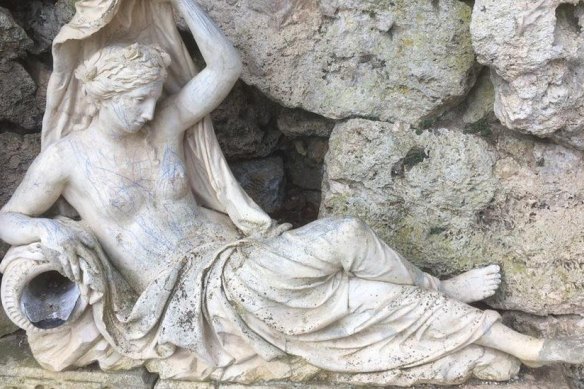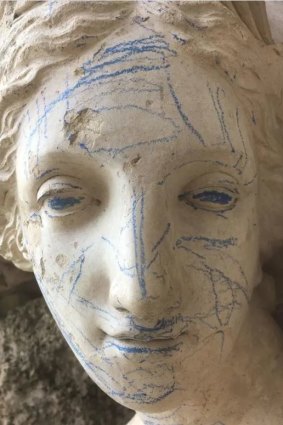A statue was preserved for centuries. Then it was covered in blue crayon

Save articles for later
Add articles to your saved list and come back to them any time.
The mythological story of the Roman water nymph Sabrina was written in the 12th century, and a statue depicting her has been on display in Britain since the 1800s.
But this month, an unidentified artist gave the sculpture a new look when blue crayon was scribbled across the ceramic body, face and eyes. The statue was defaced after an Easter event at historic Croome Court, where children visiting the mansion and its gardens were given a pack of crayons, according to the BBC.
A statue depicting Roman water nymph Sabrina, on display in Britain since the 1800s, was given a new look with blue crayon.Credit: National Trust
A memorial for Lancelot “Capability” Brown, a famous landscape architect who designed the estate’s gardens, was also covered in blue crayon, according to the National Trust, an organisation that protects historic buildings and gardens.
“We were dismayed that this happened and the team at Croome was understandably upset at the discovery,” a National Trust spokesperson said in a statement.
John Bacon sculpted the statue of Sabrina around 1802, according to the National Trust. It acquired the sculpture and its surrounding land in 1996 and has welcomed the public since.
The scribbling was discovered after an Easter event where children were handed crayons for attending. Credit: National Trust
The blue crayon scribbles appeared on the statue around April 9, and its beige eyes became blue.
A mild detergent removed the crayon from the Sabrina statue, but David Bindman, an emeritus professor of the history of art at University College London, said it could have suffered more damage if it had not been built with Coade stone, a hard and durable material.
“It’s very resilient,” Bindman said.
Efforts are still being made to clean up Brown’s memorial, which notes that “his inimitable and creative genius formed this garden scene.” Some of those words are now difficult to read with blue crayon covering them.
The British estate is not the first place to experience vandalism by crayon. In 2021, employees at a Kansas museum noted that one of its Buddha sculptures was permanently stained after someone marked the statue’s leg with a blue crayon.
The Museum of World Treasures responded by explaining the difficulties of removing the crayon in a notice on its website titled “Museum Etiquette: What you can do to help us preserve our artifacts.” Employees were able to remove some – but not all – of the crayon with dental tools, a small brush with stiff bristles and mild liquid soap.
“While this process helped clean away most of the bright blue crayon, it may never be possible to entirely remove it from the artifact’s surface,” the museum added.
A 2011 study examined different methods to remove crayon “graffiti” from Japanese artist Shiko Munakata’s prints. After several tests, the author concluded that “no solvent works perfectly” in removing the crayon markings.
Washington Post
Most Viewed in World
From our partners
Source: Read Full Article

